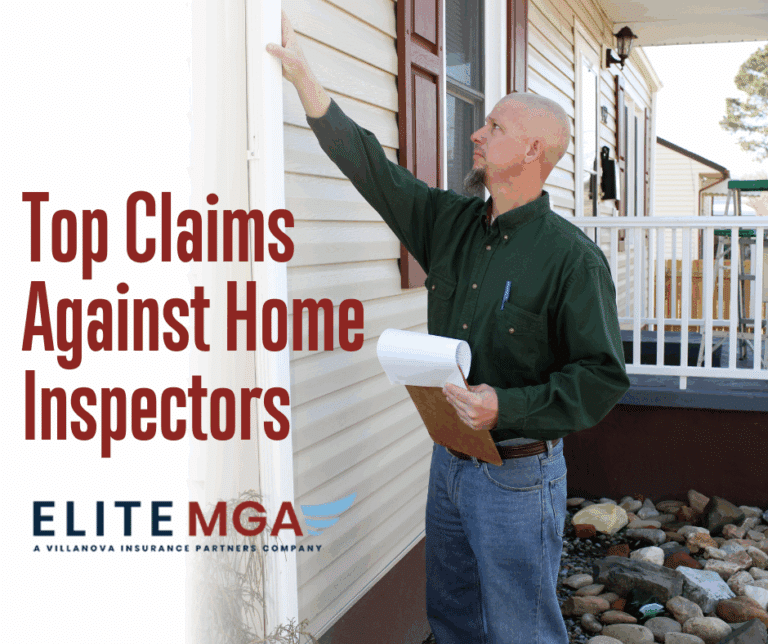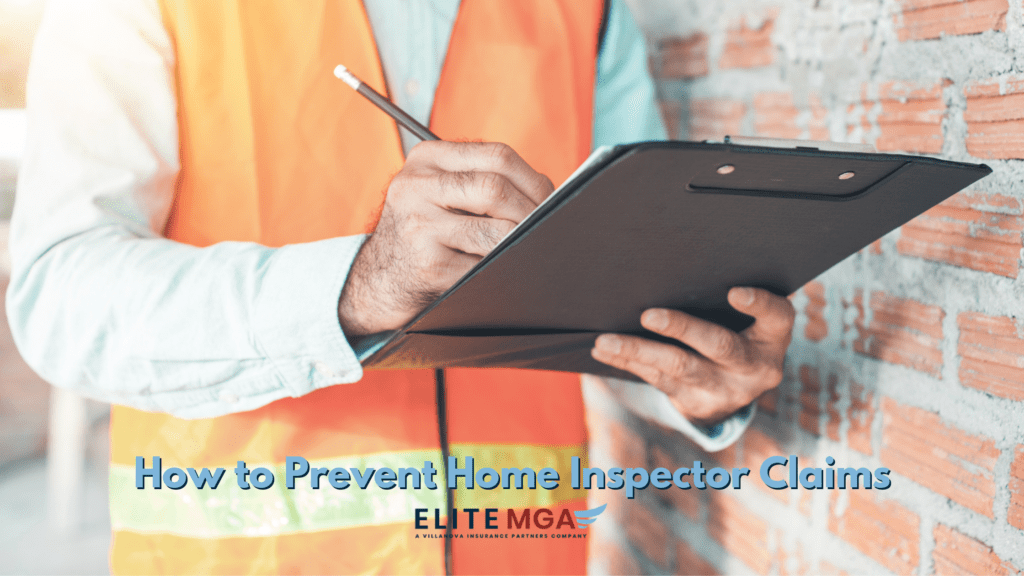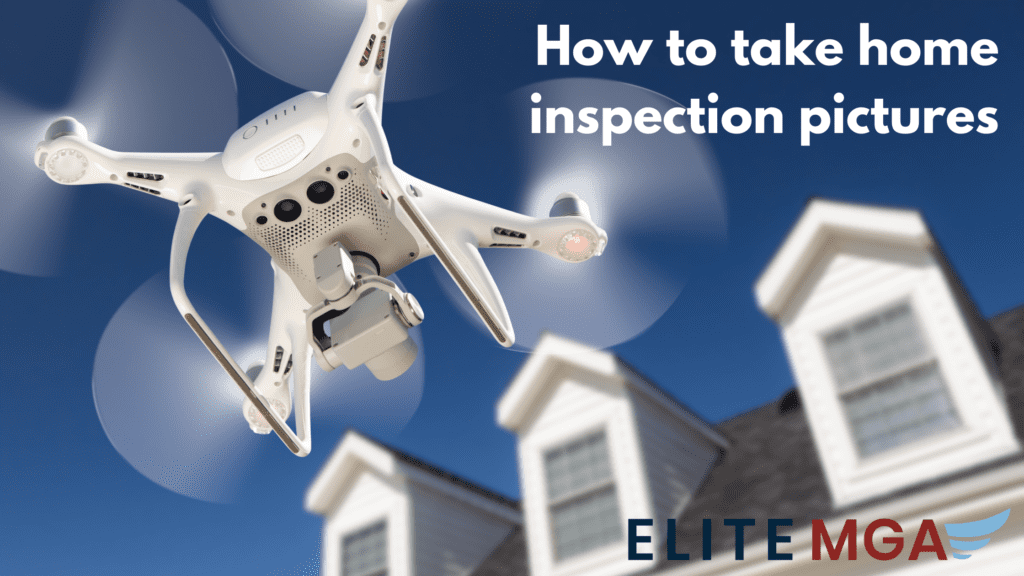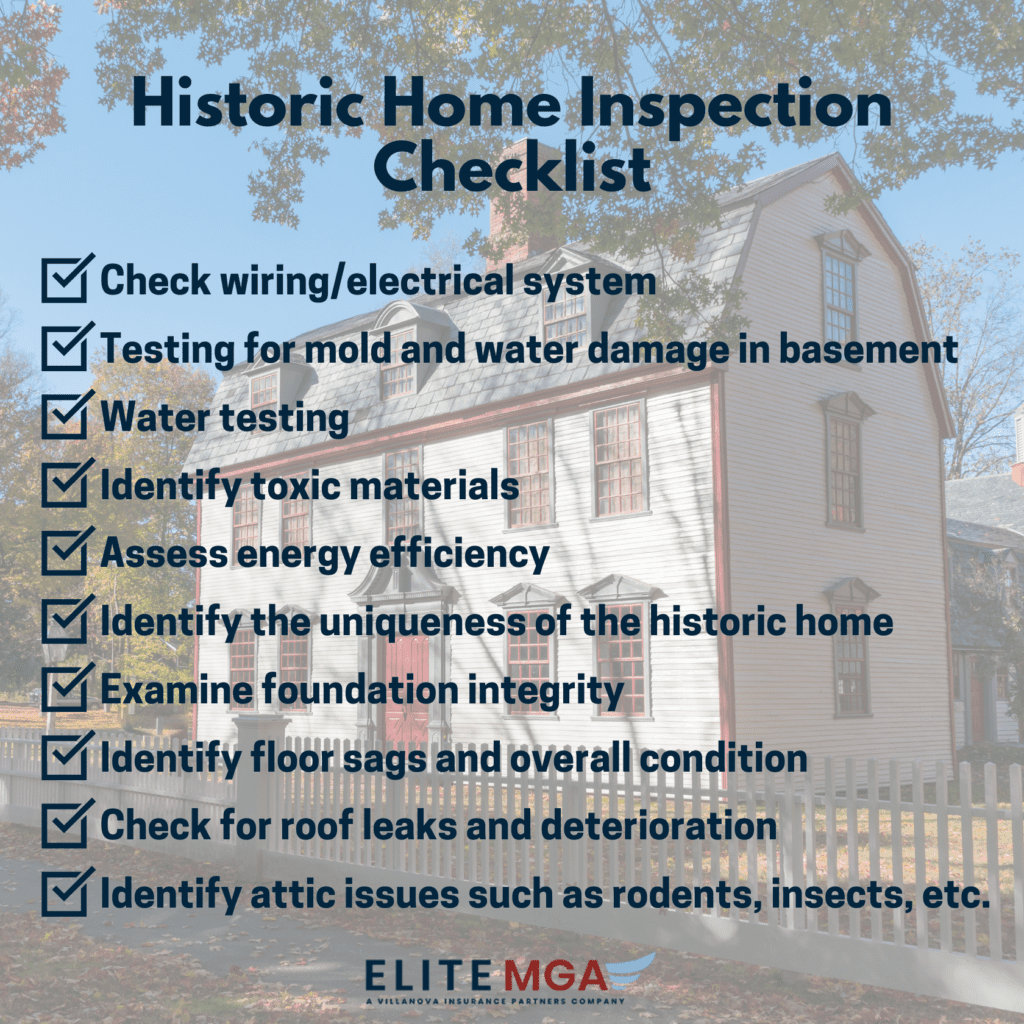
Home inspectors face unique liability risks on nearly every job. There are several common liability claims against home inspectors, including:
- Roofing Damage
- Mold
- Problematic Plumbing
- Defects in the Foundation
- Water Damage
- Power issues
- HVAC Failure
- Termite Damage
- Flashing Failure
These mistakes can lead to costly lawsuits, unhappy clients, and damage to your professional reputation.
In this guide, we’ll break down the top 6 claims against home inspectors, why they happen, and the steps you can take to prevent them. We’ll also explain how carrying Errors and Omissions (E&O) insurance for home inspectors can protect you from unexpected financial loss.
1. Roofing Damage Claims Against Home Inspectors
Claim Example of a Ceiling Hole
Accidents can happen during home inspections, especially in attics. One home inspection claim involves a home inspector who fell through the ceiling while navigating an attic, creating a hole and damaging the kitchen below. Repairs for such incidents can be costly, as evidenced by a case where repairs totaled $900. This incident underscores the importance of prioritizing safety during attic inspections to prevent home inspector negligence claims.
Why Roofing Claims Are Common?
Most attics lack safe, consistent walking surfaces. They’re typically filled with a maze of trusses, framing elements, and loose boards – all presenting a significant risk if stepped on.
How to Reduce Risk As A Home Inspector
Always prioritize safety when entering an attic. Avoid attics lacking proper walkways or sufficient headroom. Postpone inspection if insulation completely conceals the ceiling joists, as hidden hazards might be present. Approach makeshift walkways made from loose planks with caution; their stability is unreliable. Ultimately, your goal is a safe inspection that avoids property damage or personal injury. If navigating the attic proves unsafe, inspect it from the access point and clearly document this limitation and the reason in your report to reduce the risk of home inspection disputes or malpractice claims home inspectors may face.
2. Mold Claims in Home Inspections
Claim Example of a Bathroom Mold
Relying solely on a home inspector’s visual assessment can leave new homeowners vulnerable to hidden mold problems. A common home inspection claim involves an inspector giving the “all clear” for mold, only for the new residents to discover extensive growth behind bathroom tiles later. Mold spores, invisible to the naked eye, can trigger respiratory issues and require costly professional remediation to remove safely.
Why Mold Claims Are Common?
Mold, a sneaky home inhabitant, thrives in damp and dark environments. Unfortunately, a standard visual inspection by a home inspector might miss mold lurking in unseen areas. Moisture leaks or condensation can cause mold to grow behind bathroom tiles or even within wall cavities, leading to home inspector legal claims if undetected. Carpeting or flooring can also conceal mold growth, creating a hidden breeding ground beneath the surface. Attics with limited headroom or those cluttered with insulation pose similar challenges for thorough inspections, potentially leaving mold spores undiscovered in unseen corners.
How to Reduce Risk As A Home Inspector
Moisture meters can be valuable allies in uncovering hidden mold issues. By detecting hidden moisture within walls, floors, or ceilings, these tools can pinpoint areas with a higher risk of mold growth. Always prioritize a thorough visual inspection in moisture-prone areas like bathrooms, kitchens, laundry rooms, and basements and document in your report to reduce exposure to E&O claims home inspectors may face. Look for telltale signs like discoloration, musty odors, or warped surfaces, which might indicate hidden mold. If suspicion arises but confirmation remains elusive, advise the potential buyer to consult a mold specialist. Their expertise and specialized equipment can offer a more definitive diagnosis. Finally, transparency is key. Clearly outline in your report any areas that are inaccessible or pose difficulty for complete examination.
3. Plumbing-Related Liability for Home Inspectors
Claim Example of Frozen Plumbing
In a late-winter inspection in the Northeast, an inspector turned off the boiler to examine the chimney flue. Unfortunately, after the inspection, the boiler was inadvertently left off. The resulting drop in home temperature caused the pipes to freeze and burst, leading home inspection claim cost nearly $6,000 for replacing the damaged plumbing.
Why Plumbing Claims Are Common?
During home inspections, especially in winter, it’s easy to forget to turn major systems back on after shutting them down for examination. This oversight can be costly, as evidenced by frequent frozen plumbing claims linked to inspector negligence & can easily trigger home inspector insurance claims, particularly in cold climates. Inadequate sealing of crawlspace access points can leave the home vulnerable to cold air, potentially affecting other systems and contributing to potential damage.
How to Reduce Risk As A Home Inspector
To ensure comprehensive and reliable results, home inspections should follow proper risk management & a standardized procedure every time, which can minimize claims and lawsuits home inspectors face due to negligence. Additionally, during winter inspections, double-checking that the heating system is functional before leaving the property is vital for a complete assessment, especially for systems susceptible to issues in freezing temperatures.
4. Foundation Defects Missed During Inspections
Claim Example of a Foundation Cracks
A home inspection concludes with a positive assessment of the foundation. Unfortunately, after purchasing the property, the new owners discover significant cracks and uneven settling. These foundation problems lead to structural issues throughout the house, necessitating costly repairs & home inspection claims.
Why Foundation Claims Are Common?
Identifying foundation defects can be challenging. Subtle cracks and minor settling may go unnoticed without a meticulous inspection. Here’s what to consider:
- Hairline cracks: These can be difficult to spot, especially if they’re not leaking. A thorough inspection will involve close scrutiny of the foundation for any irregularities.
- Specialized tools: Standard inspections may not include using specialized leveling instruments. These tools can detect even minor settling issues that could indicate a more serious problem.
How to Reduce Risk As A Home Inspector
For a thorough foundation inspection, follow these key steps
- Meticulous Visual Examination: Closely examine foundation walls for cracks, signs of uneven settling, or misalignment. Utilize a flashlight to inspect dark or hard-to-reach areas.
- Beyond Visual Inspection: Don’t limit your assessment to sight alone. Consider employing leveling tools to identify potential settling issues that may not be immediately obvious.
- Seeking Professional Expertise: If you encounter concerning signs of foundation problems, strongly recommend that the potential buyer consult with a structural engineer. Their specialized knowledge can provide a more detailed assessment and pinpoint any necessary repairs.
- Detailed Reporting: Document the foundation’s condition comprehensively in your report to reduce the risk of home inspector legal claims. Include details about any cracks observed, your evaluation of their severity, and acknowledge any limitations of your inspection, such as restricted access to specific areas.
5. Water Damage Claims Against Home Inspectors
Claim Example of a Water Damage
While examining the plumbing system, the home inspector turned on the water supply. Unfortunately, they neglected to properly shut off a small water line in the basement after the inspection. This resulted in the line leaking for two days, causing flooding and over $4,500 in damage. This scenario demonstrates common home inspector negligence claims.
Why Water Damage Claims Common?
Inspecting a home’s water system often involves running water through numerous fixtures and appliances. The sheer number of components can make it easy to miss shutting off a single supply line. Unfortunately, such an oversight can lead to significant water damage, especially if the leak remains undetected for a long time.
How to Reduce Risk As A Home Inspector
Thoroughness is key during a plumbing inspection. Rushing the process by leaving the water on can lead to missed shut-off valves. Develop a systematic approach to ensure every water source is turned off before leaving the property. Double-checking all potential water sources for shutoff provides an extra layer of protection against accidental leaks, home inspection disputes or E&O claims for home inspectors.
6. Electrical & Power-Related Inspection Claims
Claim Example of Power Outage
During testing of the exterior outlets, the home inspector tripped a GFCI circuit in the garage. Unfortunately, due to cluttered storage, locating the specific outlet for reset proved difficult. While the inspector noted this issue in the report, subsequent parties reviewing the report may have missed it. In this instance, the homeowner, a scientist utilizing the garage for storing rare seeds in three refrigerators, encountered a significant loss due to a tripped GFCI breaker. Fortunately for the inspector, the homeowner ultimately withdrew the $500,000 claim for reasons independent of the inspection.
Why Electrical Claims Are Common?
Tripped circuit breakers and Ground Fault Circuit Interrupters (GFCIs) can pose challenges during inspections. Food spoilage is a frequent concern raised by both inspectors and homeowners. The Food and Drug Administration (FDA) offers guidelines: a full refrigerator can maintain safe temperatures for up to four hours during a power outage, while a half-full freezer can last for approximately 24 hours. Beyond these timeframes, food spoilage becomes a risk. While not all sellers possess extensive knowledge of food preservation, the growing popularity of healthy and organic options means potential losses due to power disruptions can be significant.
How to Reduce Risk As A Home Inspector
The initial power state of an inspection property can vary. Document whether the power is on upon arrival and ensure it’s returned to that state when you finish. If the powe r is expected to be on, comprehensively test outlets throughout the house, prioritizing critical appliances like refrigerators and freezers. Remember to securely close any appliance doors you may open during inspection. In the event of an unintended power outage during the inspection, prioritize informing the current occupants to facilitate a swift restoration and minimize potential losses. It’s important to note that some inspectors, particularly in regions with a strong hunting culture, may adjust their approach to avoid tripping breakers or GFCIs connected to large freezers. Open communication with the occupants beforehand can help reduce malpractice claims home inspectors might face.
7. HVAC System Liability Claims
Claim Example of HVAC Failure
A home inspector cleared the HVAC system as functional during an early spring inspection. Months later, when the new homeowners turned on the furnace for the first time, it failed completely. The homeowners filed a claim, alleging the inspector should have identified signs of wear and impending failure.
Why HVAC Claims Are Common?
HVAC systems are complex and often not fully testable during an inspection. Seasonal conditions may prevent testing the furnace or air conditioning. Visual checks may miss hidden problems like worn parts, dirty coils, or failing compressors.
How to Reduce Risk As A Home Inspector
- Operate heating and cooling systems when weather permits, and document limitations if they cannot be tested.
- Note the system’s age and condition based on manufacturer labels and visible wear.
- Advise clients that a licensed HVAC contractor can provide a more in-depth evaluation if concerns arise.
8. Pest and Termite Claims in Home Inspections
Claim Example of Termite Damages
An inspector noted no major concerns in the basement. After move-in, homeowners discovered extensive termite damage in structural beams. They alleged the inspector should have recognized the signs of infestation.
Why Pest Claims Are Common?
Termites, carpenter ants, and other pests often work behind walls, under floors, or in crawlspaces. Even visible damage may be subtle, and inspectors may not be licensed to provide formal pest inspections in some states.
How to Reduce Risk As A Home Inspector
- Look for warning signs such as mud tubes, frass (wood shavings), or hollow-sounding beams.
- Document any inaccessible areas where pests could hide.
- Clearly state in your report whether pest inspections fall outside the scope of a general home inspection.
- Recommend that buyers consult a licensed pest control professional for a dedicated inspection.
9. Roof Leak and Flashing Failure Claims
Claim Example of A Flashing Failure
An inspector reported the roof as “in good condition.” Weeks later, after heavy rain, the homeowners discovered leaks around chimneys and vents due to flashing failures. Repair costs exceeded $10,000, and the inspector faced a liability claim.
Why Roof Leak Claims Are Common?
Roofs can appear sound during a dry inspection day. Flashing, sealants, and underlayment issues may not be visible from a simple visual inspection, especially if the inspector cannot safely access the roof.
How to Reduce Risk As A Home Inspector
- Document the roof’s age, material, and condition based on what is visible.
- Note any limitations if the roof cannot be walked due to steep pitch, height, or weather.
- Check for staining on ceilings, attic sheathing, or around chimneys that could indicate past leaks.
- Recommend roof specialists when concerns exist or when a full inspection isn’t possible.
Protect Yourself with E&O Insurance for Home Inspectors
Having the right insurance in place can be a lifesaver for home inspectors facing any of these home inspector insurance claims. EliteMGA offers Errors and Omissions (E&O) insurance specifically designed for home inspectors. Our E&O insurance can help cover the costs of legal defense and damages awarded in a lawsuit, giving you peace of mind knowing you’re protected.




